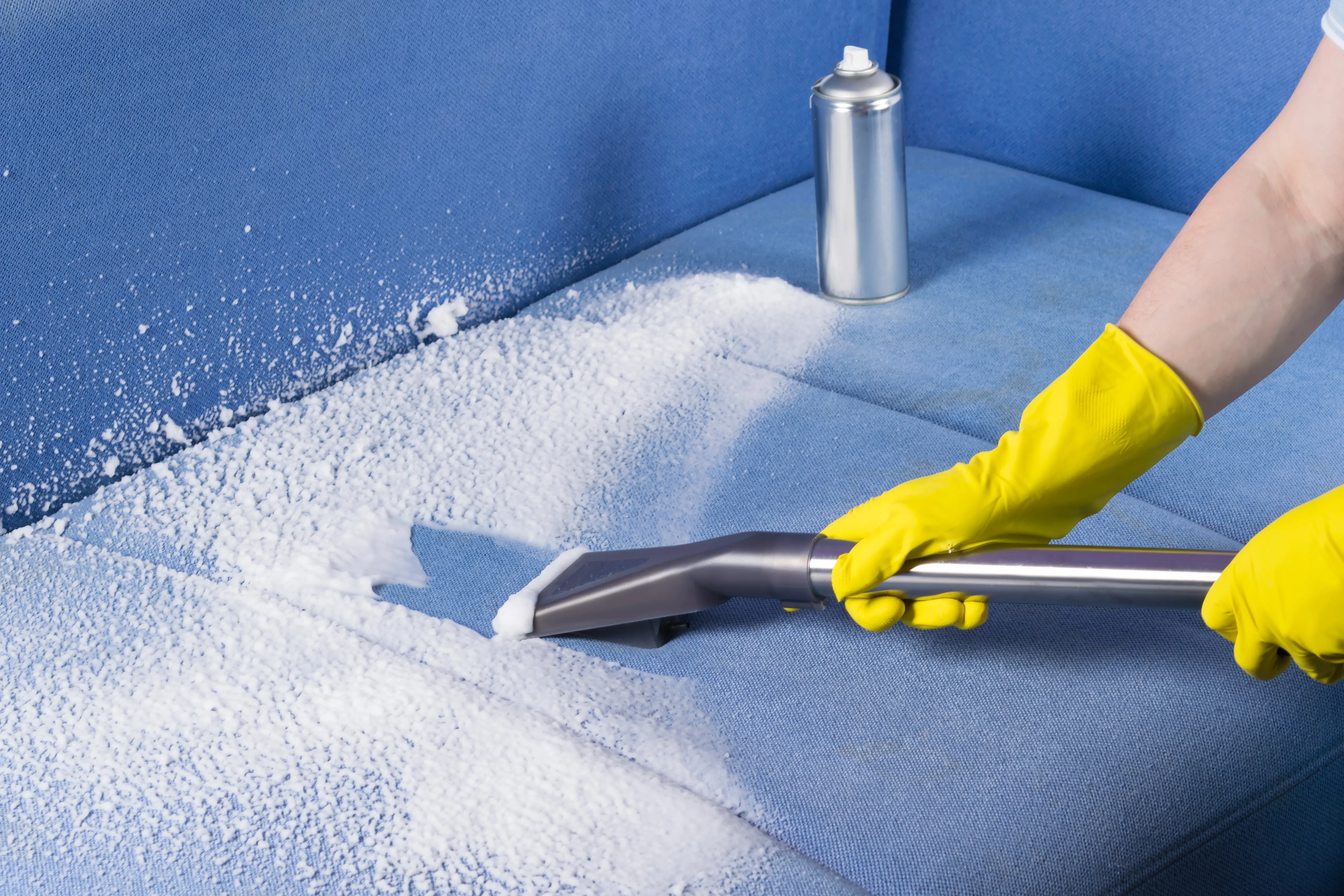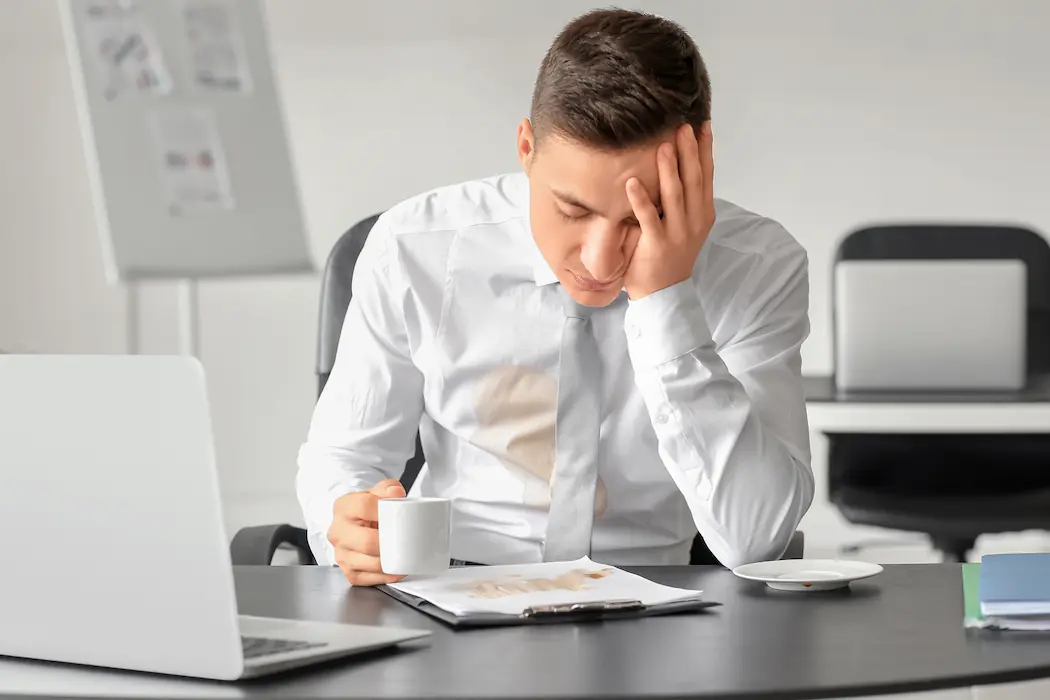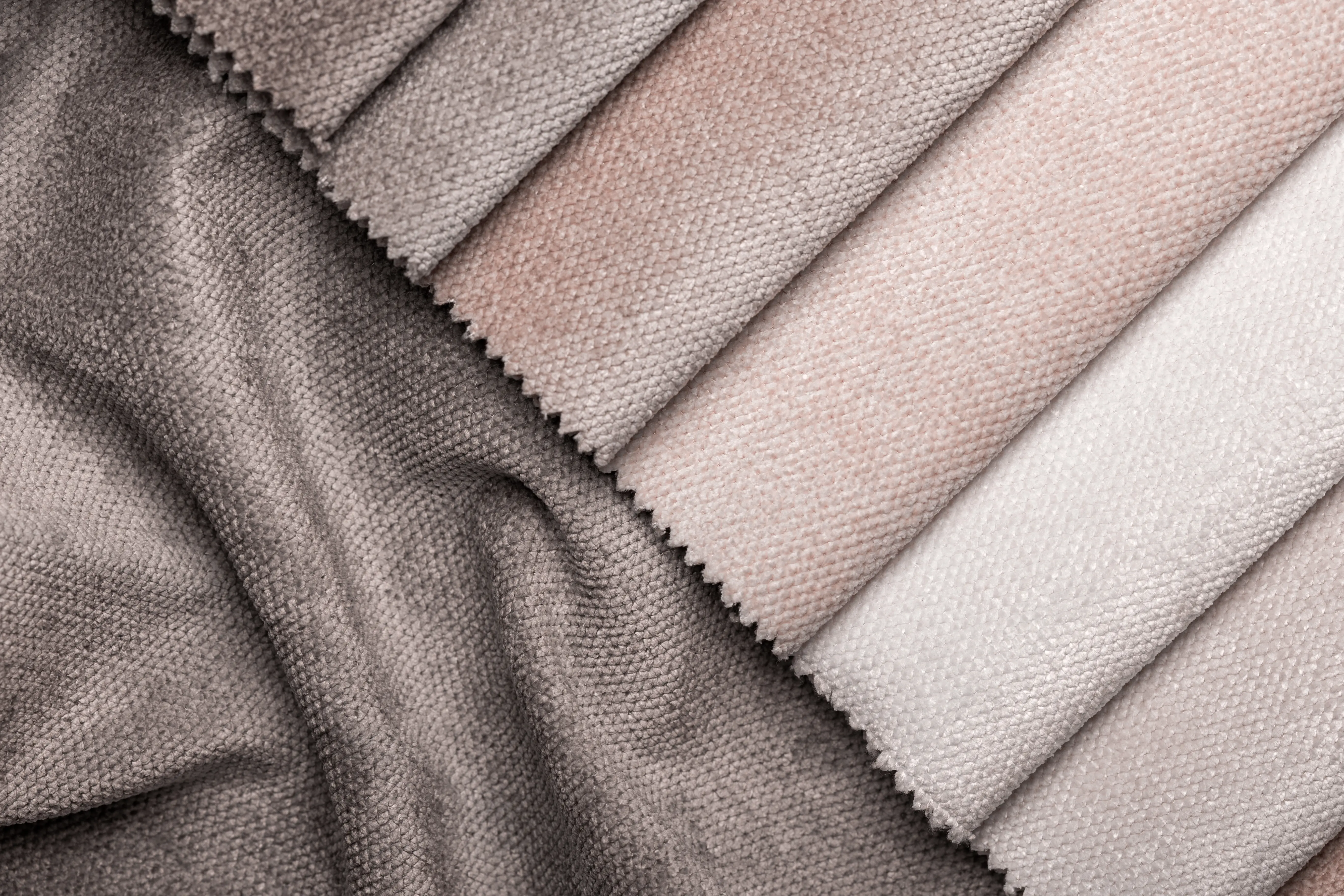
How to Remove Stains from Furniture and Upholstery: A Complete Stain Removal Guide
Accidents happen – they keep life interesting. But when you spill on your clothes or upholstery, you want to take care of those tough stains right away. As experts on this topic, our team at EuroMaids encourages you to try some of these upholstery stain removal tips and homemade cleaning hacks for getting out even the toughest stains fast so you can go back to lounging on the couch in your comfy clothes. If you're looking for a deep clean for your entire apartment, check out our professional apartment cleaning services at EuroMaids. We'll leave every room sparkling so you can truly relax.
Supplies to Keep on Hand for Stain Removal Solutions

First things first - always peek at the clothing label to see how the manufacturer recommends caring for the fabric. And if you can, do a little test spot on a hidden part of the clothing just to be safe before going all in on a stain removal technique. Some fabrics are more delicate than others, and it's better to be safe than sorry!
With the right supplies and a little know-how, you can get even old dried stains out in no time.
Here's the list of must-have stain remover products that should be part of your stain removal process and in your house:
- Stain-specific products: Keep an enzyme-based stain remover, oxygen bleaches, and spot remover pens on hand for tackling set-in stains;
- Household items for DIY solutions: Baking soda, hydrogen peroxide, vinegar, and lemon juice can be effective homemade stain fighters;
- Essential tools and materials: Absorbent cloths, soft-bristled brushes, paper towels, and a spray bottle help lift and dissolve stains;
- Protective gear for handling chemicals: Wear gloves and eye protection when using a harsh chemical stain remover.
Now that you've assembled your stain-fighting squad of supplies, it's time to battle those pesky stains! Up next, we'll share some pro tips and tricks for beating all types of common household stains. From coffee stains on your jeans to spaghetti sauce on the couch, you'll be prepared to obliterate those stains and restore your items to their original glory.
How to Remove Blood Stains from Fabric and Furniture

Blood stains can be particularly stubborn if not treated promptly.
Here's a step-by-step guide to effectively remove any blood stain from fabric or wood furniture:
- Immediate action: Act quickly! Blot the stained fabric or furniture gently with a clean cloth, avoiding rubbing, which can spread the stain;
- Pre-treatment: Create a mixture of cool water and salt or hydrogen peroxide. Soak the stained area of the fabric or furniture in this solution for 30 minutes when removing blood from your furniture;
- Washing: After pre-treatment, wash the fabric as usual, using cold water. Check the stain's status before drying; avoid heat as it can set the stain.
How to Get Stains from Chocolate on Fabric
Chocolate stains can be difficult to remove completely from fabric upholstery like sofas and chairs.
Follow these steps to help treat chocolate stains on your furniture:
- Immediate action: As soon as possible after the stain occurs on your sofa, use a dull knife or spoon to scrape off any excess chocolate from the fabric. Be careful to avoid rubbing it in;
- Pre-treatment: Cover the sofa (or chair) stain with an absorbent powder like cornstarch or talcum powder and let sit for 10-15 minutes. This will help draw out the oils. Gently brush off the powder;
- Washing: Apply a liquid detergent directly to the spot and let soak in for a few minutes. Then, hand wash the fabric in cool water, being careful not to spread the stain. For set-in stains, make a paste of detergent and water and let sit on the spot for 30 minutes before washing.
Avoid using hot water when washing chocolate stains out of sofa or chair fabrics, as heat can set them. With the right process, even difficult chocolate stains can be removed from upholstered furniture.
Removing Tea or Coffee Stains on Fabric

Spilled coffee or tea can leave unsightly stains on your couch.
Here's how to treat this type of stain:
- Immediate response to coffee spills: Blot the stain immediately with a clean cloth or paper towel to absorb the liquid. Avoid rubbing as this can set the stain on your couch or chairs;
- Home remedies for coffee or tea stain removal:
1. White vinegar and baking soda: Create a stain remover paste using white vinegar and soda. Apply it to the stain, let it soak for 15 minutes, then rinse with cold water;
2. Lemon juice and salt: Mix lemon juice and salt to form a paste. Apply it to the wet stain and let it sit for a few minutes before rinsing. - Treating coffee stains on various surfaces: The methods mentioned above can be used for fabric, carpet cleaning, couch and chair upholstery, and even coffee mugs;
- Washing and post-treatment for coffee-stained items: After treating the stain, wash the fabric as usual. Then, inspect the area closely to ensure no visible stain remains before drying the fabric.
How to Remove Powdered Cosmetics from Fabric

Removing powdered cosmetics like eyeshadow and blush from a fabric takes a different approach than oil-based stains.
Follow these steps:
- Immediate action: As soon as possible after the stain occurs, gently shake off any excess powder from the fabric;
- Pre-treatment: Apply a liquid stain remover or liquid laundry detergent directly to the stained area. Let it soak in for 10-15 minutes to help break down the pigments;
- Washing: Launder the clothing or upholstery using the hottest water that's safe for the fabric. The heat will help lift the stain residues from the fibers. Avoid rubbing or scrubbing the stain to prevent grinding in the powder.
With pretreatment and hot water washing, you can often completely remove powdered cosmetics stains. Check the care label and use the hottest water temperature appropriate for the fabric type.
How to Remove Grass Stains on Fabric
Grass stains on clothes are common, especially on outdoor clothing.
Here's how to tackle those green grass stains from clothes:
- Initial steps: Scrape off excess grass with a blunt knife or spoon. Avoid rubbing, which can push the stain deeper into the fabric;
- Grass stain pre-treatment: Apply a mixture of white vinegar and liquid detergent to the stain and let it sit for 15 minutes;
- Washing and post-treatment: Wash the item as usual, using cold water. Check the stain before drying and repeat the process if needed.
How to Get Grease and Oil Stains Out of Fabric

When it comes to eliminating an oil stain, certain techniques can prove useful whether you're cleaning clothes or performing upholstery cleaning.
Effective methods for removing greasy stains from fabrics include:
- Initial oil stain treatment: Blot the excess oil with a clean cloth or paper towel to absorb as much oil as possible. Avoid rubbing to prevent the oil from spreading;
- Home remedies to remove stains left after an oil:
1. Baking soda and dish soap: Make a stain remover paste using soda and dish soap. Apply it to the stain and leave it for 30 minutes before washing;
2. Cornstarch or talcum powder: Sprinkle cornstarch or talcum powder on the stain to absorb the oil. Let it sit for a few hours, then brush it off before washing. - Special considerations for delicate fabrics: For delicate fabrics like silk, wool, and leather, consult a professional cleaner for oil stain removal to avoid damage;
- Washing and post-treatment for oil stains: After treating the stain, wash the fabric following the care label instructions. Carefully inspect the fabric to ensure no stain remains are still visible before drying the item.
Tips for Removing Ink Stains from Fabric
Treating ink stains properly is key for removal.
Follow these steps:
- Immediate action: Sponge the area around the stain with rubbing alcohol or cleaning fluid before applying it directly to the stain. This prevents it from spreading;
- Pre-treatment: Place the stained fabric face down on clean paper towels. Apply alcohol or cleaning fluid to the back of the stain. Be sure to replace the paper towels frequently as it pulls out the ink;
- Washing: Once pre-treated, rinse the fabric thoroughly under cool running water. Then launder as usual with detergent and the hottest water safe for the fabric.
With this process of applying solvents to the back first and rinsing thoroughly after pre-treating, even a dried and set-in ink stain can often be removed successfully.
How to Remove Juice Stains on Fabric

Removing stains from juice can be hard, but it is possible with the right cleaning method:
- Immediate action: Blot up any excess juice immediately after a spill occurs. Do not rub the fabric;
- Pre-treatment: Apply an enzyme-based pre-treatment or soak the stain in a product containing enzymes. Let it sit for at least 30 minutes, or up to several hours for set-in stains;
- Washing: Launder using the hottest water safe for the fabric. Enzymes will further help release the sugars and food particles.
For stubborn stains that remain, use bleach designed for the fabric type. Always check the care label before you do so.
How to Remove Food and Sauce Stains from Upholstery
When dealing with stains on upholstered furniture and carpets, you'll want to take special care to remove stains from furniture and prevent any potential permanent damage.
Follow these helpful tips:
- Immediate action: Quickly blot up any excess spilled food from upholstery using a paper towel. This prevents the stain from setting in;
- Pre-treatment: Mix 2 cups cold water, 1 tablespoon dishwashing liquid or laundry detergent, and 1 tablespoon white vinegar if the stain contains red, orange, or purple dyes. Generously apply this solution to the stain;
- Cleaning: Blot the pre-treatment solution into the upholstery or carpet using clean cloths. Avoid rubbing or scrubbing. Rinse the area thoroughly with a wet cloth to remove detergent residue.
With prompt blotting, specialized pre-treatment mixes, and the proper blotting technique, food stains can often be removed from delicate upholstery and carpet fabrics. Whatever you do, it's important to avoid abrasion and immediately treat stains before they dry and set.
How to Remove Grease Stains from Upholstery

Grease stains can pose a challenge, especially on delicate upholstery fabrics like your sofa or chairs.
To ensure the beauty and longevity of your furniture, follow these expert tips:
- Immediate action: Act swiftly when a grease spill occurs on your sofa or chairs. Apply a thick layer of baby powder directly onto the stain as soon as possible. This quick response helps absorb grease from the fabric effectively;
- Treatment: Let the baby powder sit for a few minutes then brush it off. The powder will lift the grease out of the fibers;
- Spot cleaning: Use an upholstery-approved cleaner and gently blot the remaining stain. Avoid over-wetting the surrounding fabric.
If these stains make you feel uncertain about the condition of your beloved sofa or chairs, it may be time to leave it to the experts. Explore our professional upholstery cleaning services for a deep clean and a refreshed appearance that'll leave your furniture looking as good as new.
How to Clean Pet Stains from Carpets
We love our furry friends, but they can sometimes damage our carpets. Pet stains like urine require specialized treatment to avoid permanent damage.
Follow these steps:
- Immediate action: Absorb wet stains ASAP by blotting with paper towels. Avoid scrubbing which can spread the urine;
- Pre-treatment: Mix 1 cup distilled white vinegar, 1 cup water, and 2 tsp baking soda in a spray bottle. Shake well and spray it onto the stain, letting sit for a few minutes;
- Cleaning: Blot the area with clean towels until the stain is removed. The vinegar helps neutralize odors while the soda deodorizes.
For tough, dried pet urine stains, consider professional carpet cleaning. Regardless of your approach, the key is to take quick action and use pet-formulated enzymatic cleaners.
Removing Red Wine Stains from Carpet

A spilled glass of red wine can be a disaster, but with the right approach, you can salvage this type of stain on your clothing.
Here's how to remove a red wine stain:
- Immediate action: Blot the stain with a clean cloth or paper towel to absorb excess wine. Avoid rubbing as this will make it worse;
- Red wine stain removal methods:
1. Salt and club soda: Cover the stain with salt and pour club soda over it. Blot, then rinse with cool water and allow it to air dry;
2. White wine counterintuitive method: It sounds risky, but you can also pour white wine on the stain to dilute the red wine. Blot, then rinse with cold water. - Using commercial stain removers: If the stain persists, consider using a commercial stain remover. Follow the product's instructions carefully;
- Final laundering and stain assessment: Wash the fabric as usual, but ensure the stain is completely gone before drying. Heat can set the stain permanently.
Don't miss our guide on clever floor and carpet cleaning hacks. Learn tips and tricks for refreshing carpets, hardwood, tile, and more throughout your home.
How to Clean Mud Stains from Upholstery

Mud can be tricky to remove from upholstery without causing excess moisture damage.
Use these steps:
- Let the mud dry completely: then vacuum up any dried dirt or debris. This removes what you can without wetting the fabric;
- Mix 1 tablespoon liquid dishwashing detergent with 2 cups of cool water in a bowl;
- Dip a clean white cloth into the solution and gently sponge the mud stain. Try not to oversaturate the surrounding fabric;
- Blot continuously with dry sections of the cloth until all the detergent solution is absorbed.
The key is to let the mud dry first, use a light detergent solution, sponge, and blot instead of rubbing, and absorb all the moisture. By following these tips on how to remove upholstery stains, you can remove mud from upholstery without the risk of permanent water marks or damage.
How to Remove Water Stains from Wood Furniture
Water rings, spots, and stains on cherished wood furniture can be upsetting.
But don’t worry, with a little effort you can often remove minor water damage:
- For minor stains, make a cleaning solution of equal parts white vinegar and olive oil. Use a soft cloth dipped in the solution to gently rub the affected area. The vinegar will help neutralize the stain while the oil conditions the wood;
- For deeper stains, gently mix non-gel toothpaste and baking soda into a paste. Carefully rub the paste onto the stained spot using a damp, clean cloth. Wipe away the residue with a dry cloth and repeat if needed.
Finally, polish the clean area with furniture wax or oil to blend it with the surrounding finish.
Stain Remover Tips for Specific Fabrics

When attempting to remove stains, it's key to consider the fabric you're working with, as different fabrics require different techniques. Specific care must be taken to avoid damaging delicate materials.
The following recommendations provide fabric-specific guidance for effective stain treatment:
- Cotton: Cotton is generally easy to clean. Blot stains with a mixture of white vinegar and water, then wash as usual;
- Polyester: Polyester can be stain-resistant. Pre-treat with a mixture of water and dish soap before washing;
- Wool: Wool is delicate; use cold water to blot stains and consider professional cleaning for tough stains;
- Silk: Blot silk stains with cold water and avoid rubbing. If there are old stains, you'll want to seek professional cleaning;
- Leather: Leather requires special care. Always use a leather cleaner for stains and condition regularly;
- Suede: Brush suede stains gently with a suede brush and use a suede cleaner for more stubborn stains.
Approaching Stains with Confidence through Our Stain Removal Guide
In the battle against household stains, preparedness, and fast action are your greatest allies. It's also helpful to keep the right supplies on hand and know the appropriate techniques for various stains to help you maintain your clothing and fabrics in top condition.
Remember, stains are a part of life, but with these comprehensive stain removal tips from Naperville's leading cleaning company, you can face them with confidence and ensure your belongings stay looking their best. Don't wait – tackle those stains head-on and enjoy a stain-free, spotless home. Get a quote today!
Related Posts

August 1, 2023
How to Clean a Medical Office Effectively
Discover the cleaning procedures for medical offices from the experts at EuroMaids. Get your medical office cleaning done right!
Read more
April 27, 2023
How to Clean Dirty Windows
Get the best tips on properly washing your windows inside & out! Learn how to prepare the cleaning solution, correctly wash from top-to-bottom without streaks.
Read more
March 31, 2023
How to Clean Construction Dust: 6-Step Cleaning Guide
Learn the best tips for post-construction clean up of your home. Find out which tools & products are most effective at getting rid of dust from a renovation!
Read more
December 22, 2023
How to Clean Walls with Flat Paint
Discover the best ways on how to clean walls with flat paint in our comprehensive guide. Get tips from Naperville's top cleaning pros.
Read more


